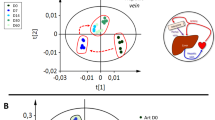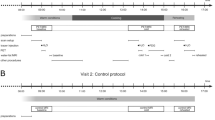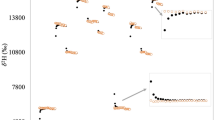Abstract
INTRODUCTION: Adipose tissue blood flow (ATBF) increases after meal intake and a failure to regulate ATBF in the postprandial period seems to be a feature of insulin resistance and obesity. ATBF can be measured quantitatively by the 133Xe washout technique, but the microdialysis ethanol escape method has also been employed to detect relative changes in ATBF.
METHODS: We compared 133Xe washout and the recovery of exogenous ethanol and endogenous urea by microdialysis in abdominal subcutaneous adipose tissue, after physiological stimulation of ATBF by ingestion of oral glucose (75 g) in eight healthy people (age 23–52 y, body mass index (BMI) 19.4–29.6 kg/m2).
RESULTS: The ATBF response was heterogeneous. In subjects responding vigorously to the stimulus as measured by 133Xe washout, the microdialysis ethanol escape was increased (indicating an increase in ATBF). An increased recovery of urea was observed, also indicating an increase in ATBF. The recovery of both small molecules was delayed compared with increased blood flow and failed to return to baseline in response to a rapid decline in ATBF.
CONCLUSION: We conclude that the 133Xe washout technique is more responsive to physiological change in ATBF than ethanol escape or urea recovery by microdialysis.
This is a preview of subscription content, access via your institution
Access options
Subscribe to this journal
Receive 12 print issues and online access
$259.00 per year
only $21.58 per issue
Buy this article
- Purchase on Springer Link
- Instant access to full article PDF
Prices may be subject to local taxes which are calculated during checkout


Similar content being viewed by others
References
Samra JS, Simpson EJ, Clark ML, Forster CD, Humphreys SM, Macdonald IA, Frayn KN . Effects of epinephrine infusion on adipose tissue: interactions between blood flow and lipid metabolism Am J Physiol 1996 271: E834–839.
Bülow J, Madsen J . Influence of blood flow on fatty acid mobilization from lipolytically active adipose tissue Pflügers Archiv 1981 390: 169–174.
Bu_low J . Human adipose tissue blood flow during prolonged exercise, III. Effect of beta-adrenergic blockade, nicotinic acid and glucose infusion Scand J Clin Lab Invest 1981 41: 415–424.
Bülow J, Madsen J, Astrup A, Christensen NJ . Vasoconstrictor effect of high FFA/albumin ratios in adipose tissue in vivo Acta Physiol Scand 1985 125: 661–667.
Ailhaud G . Adipose tissue as an endocrine organ Int J Obes Relat Metab Disord 2000 24(Suppl 2): S1–S3.
Summers LKM, Samra JS, Frayn KN . Impaired postprandial tissue regulation of blood flow in insulin resistance: a determinant of cardiovascular risk? Atherosclerosis 1999 147: 11–15.
Larsen OA, Lassen NA, Quaade F . Blood flow through human adipose tissue determined with radioactive xenon Acta Physiol Scand 1966 66: 337–345.
Samra JS, Frayn KN, Giddings JA, Clark ML, Macdonald IA . Modification and validation of a commercially available portable detector for measurement of adipose tissue blood flow Clin Physiol 1995 15: 241–248.
Felländer G, Linde B, Bolinder J . Evaluation of the microdialysis ethanol technique for monitoring of subcutaneous adipose tissue blood flow in humans Int J Obes Relat Metab Disord 1996 20: 220–226.
Lafontan M, Arner P . Application of in situ microdialysis to measure metabolic and vascular responses in adipose tissue Trends Pharmac Sci 1996 17: 309–313.
Kerckhoffs D, Arner P, Bolinder J . Lipolysis and lactate production in human skeletal muscle and adipose tissue following glucose ingestion Clin Sci 1998 94: 71–77.
Rosdahl H, Lind L, Millgard J, Lithell H, Ungerstedt U, Henriksson J . Effect of physiological hyperinsulinemia on blood flow and interstitial glucose concentration in human skeletal muscle and adipose tissue studied by microdialysis Diabetes 1998 47: 1296–1301.
Karpe F, Fielding BA, Ilic V, Humphreys SM, Frayn KN . Xenon washout and microdialysis ‘ethanol escape’ techniques give discrepant results when monitoring changes in adipose tissue blood flow after oral glucose Proc Nutr Soc 2001 60: 106A.
Clark ML, Humphreys SM, Frayn KN . Stability of plasma glucose during storage Ann Clin Biochem 1990 27: 373–377.
Felig P . Amino acid metabolism in man A Rev Biochem 1975 44: 933–955.
Strindberg L, Lonnroth P . Validation of an endogenous reference technique for the calibration of microdialysis catheters Scand J Clin Lab Invest 2000 60: 205–212.
Hickner RC, Rosdahl H, Borg I, Ungerstedt U, Jorfeldt L, Henriksson J . Ethanol may be used with the microdialysis technique to monitor blood flow changes in skeletal muscle: dialysate glucose concentration is blood-flow-dependent Acta Physiol Scand 1991 143: 355–356.
Enocksson S, Shimizu M, Lönnqvist F, Nordenström J, Arner P . Demonstration of an in vivo functional beta 3-adrenoceptor in man J Clin Invest 1995 95: 2239–2245.
Millet L, Barbe P, Lafontan M, Berlan M, Galitzky J . Catecholamine effects on lipolysis and blood flow in human abdominal and femoral adipose tissue J Appl Physiol 1998 85: 181–188.
Wallgren F, Amberg G, Hickner RC, Ekelund U, Jorfeldt L, Henriksson J . A mathematical model for measuring blood flow in skeletal muscle with the microdialysis ethanol technique J Appl Physiol 1995 79: 648–659.
Stallknecht B, Donsmark M, Enevoldsen LH, Fluckey JD, Galbo H . Estimation of rat muscle blood flow by microdialysis probes perfused with ethanol, [14C] ethanol, and 3H2O J Appl Physiol 1999 86: 1054–1061.
Rådegran G, Pilegaard H, Nielsen JJ, Bangsbo J . Microdialysis ethanol removal reflects probe recovery rather than local blood flow in skeletal muscle J Appl Physiol 1998 85: 751–757.
Acknowledgements
This work was funded by the Wellcome Trust.
Author information
Authors and Affiliations
Corresponding author
Rights and permissions
About this article
Cite this article
Karpe, F., Fielding, B., Ilic, V. et al. Monitoring adipose tissue blood flow in man: a comparison between the 133xenon washout method and microdialysis. Int J Obes 26, 1–5 (2002). https://doi.org/10.1038/sj.ijo.0801843
Received:
Revised:
Accepted:
Published:
Issue Date:
DOI: https://doi.org/10.1038/sj.ijo.0801843
Keywords
This article is cited by
-
Regulation of human subcutaneous adipose tissue blood flow
International Journal of Obesity (2014)
-
Arterio-venous differences in peripheral blood mononuclear cells across human adipose tissue and the effect of adrenaline infusion
International Journal of Obesity (2012)
-
Marked resistance of femoral adipose tissue blood flow and lipolysis to adrenaline in vivo
Diabetologia (2012)
-
Transcriptional Control of Human Adipose Tissue Blood Flow
Obesity (2009)
-
Heterogeneity of human adipose blood flow
BMC Clinical Pharmacology (2007)



